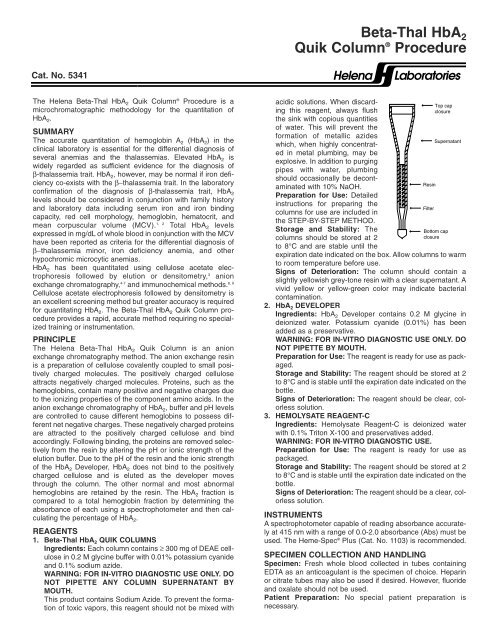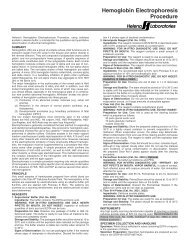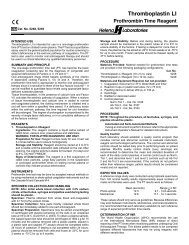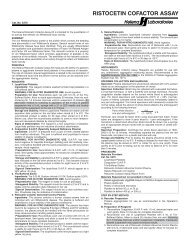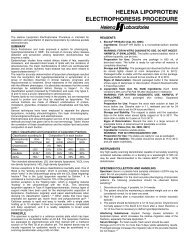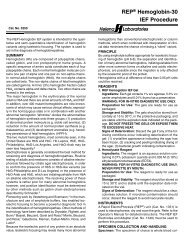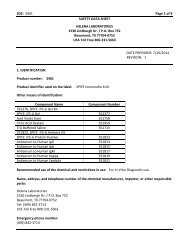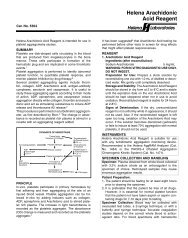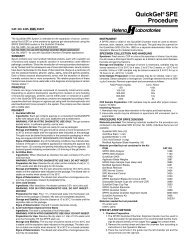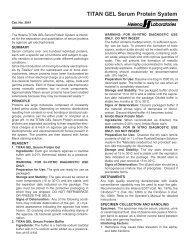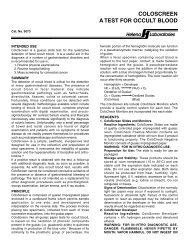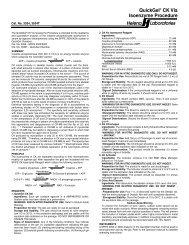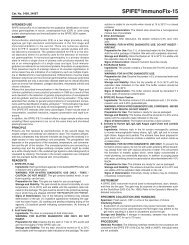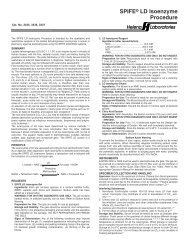Beta-Thal HbA2 Quik Column® Procedure Helena Laboratories
Beta-Thal HbA2 Quik Column® Procedure Helena Laboratories
Beta-Thal HbA2 Quik Column® Procedure Helena Laboratories
- No tags were found...
You also want an ePaper? Increase the reach of your titles
YUMPU automatically turns print PDFs into web optimized ePapers that Google loves.
<strong>Beta</strong>-<strong>Thal</strong> HbA 2<strong>Quik</strong> Column ® <strong>Procedure</strong>Cat. No. 5341<strong>Helena</strong><strong>Laboratories</strong>The <strong>Helena</strong> <strong>Beta</strong>-<strong>Thal</strong> HbA 2 <strong>Quik</strong> Column ® <strong>Procedure</strong> is amicrochromatographic methodology for the quantitation ofHbA 2 .SUMMARYThe accurate quantitation of hemoglobin A 2 (HbA 2 ) in theclinical laboratory is essential for the differential diagnosis ofseveral anemias and the thalassemias. Elevated HbA 2 iswidely regarded as sufficient evidence for the diagnosis ofβ-thalassemia trait. HbA 2 , however, may be normal if iron deficiencyco-exists with the β−thalassemia trait. In the laboratoryconfirmation of the diagnosis of β-thalassemia trait, HbA 2levels should be considered in conjunction with family historyand laboratory data including serum iron and iron bindingcapacity, red cell morphology, hemoglobin, hematocrit, andmean corpuscular volume (MCV). 1, 2 Total HbA 2 levelsexpressed in mg/dL of whole blood in conjunction with the MCVhave been reported as criteria for the differential diagnosis ofβ−thalassemia minor, iron deficiency anemia, and otherhypochromic microcytic anemias.HbA 2 has been quantitated using cellulose acetate electrophoresisfollowed by elution or densitometry, 3 anionexchange chromatography, 4-7 and immunochemical methods. 8, 9Cellulose acetate electrophoresis followed by densitometry isan excellent screening method but greater accuracy is requiredfor quantitating HbA 2 . The <strong>Beta</strong>-<strong>Thal</strong> HbA 2 <strong>Quik</strong> Column procedureprovides a rapid, accurate method requiring no specializedtraining or instrumentation.PRINCIPLEThe <strong>Helena</strong> <strong>Beta</strong>-<strong>Thal</strong> HbA 2 <strong>Quik</strong> Column is an anionexchange chromatography method. The anion exchange resinis a preparation of cellulose covalently coupled to small positivelycharged molecules. The positively charged celluloseattracts negatively charged molecules. Proteins, such as thehemoglobins, contain many positive and negative charges dueto the ionizing properties of the component amino acids. In theanion exchange chromatography of HbA 2 , buffer and pH levelsare controlled to cause different hemoglobins to possess differentnet negative charges. These negatively charged proteinsare attracted to the positively charged cellulose and bindaccordingly. Following binding, the proteins are removed selectivelyfrom the resin by altering the pH or ionic strength of theelution buffer. Due to the pH of the resin and the ionic strengthof the HbA 2 Developer, HbA 2 does not bind to the positivelycharged cellulose and is eluted as the developer movesthrough the column. The other normal and most abnormalhemoglobins are retained by the resin. The HbA 2 fraction iscompared to a total hemoglobin fraction by determining theabsorbance of each using a spectrophotometer and then calculatingthe percentage of HbA 2 .REAGENTS1. <strong>Beta</strong>-<strong>Thal</strong> HbA 2 QUIK COLUMNSIngredients: Each column contains ≥ 300 mg of DEAE cellulosein 0.2 M glycine buffer with 0.01% potassium cyanideand 0.1% sodium azide.WARNING: FOR IN-VITRO DIAGNOSTIC USE ONLY. DONOT PIPETTE ANY COLUMN SUPERNATANT BYMOUTH.This product contains Sodium Azide. To prevent the formationof toxic vapors, this reagent should not be mixed withacidic solutions. When discardingthis reagent, always flushthe sink with copious quantitiesof water. This will prevent theformation of metallic azideswhich, when highly concentratedin metal plumbing, may beexplosive. In addition to purgingpipes with water, plumbingshould occasionally be decontaminatedwith 10% NaOH.Preparation for Use: Detailedinstructions for preparing thecolumns for use are included inthe STEP-BY-STEP METHOD.Storage and Stability: Thecolumns should be stored at 2to 8°C and are stable until theResinFilterTop capclosureSupernatantBottom capclosureexpiration date indicated on the box. Allow columns to warmto room temperature before use.Signs of Deterioration: The column should contain aslightly yellowish grey-tone resin with a clear supernatant. Avivid yellow or yellow-green color may indicate bacterialcontamination.2. HbA 2 DEVELOPERIngredients: HbA 2 Developer contains 0.2 M glycine indeionized water. Potassium cyanide (0.01%) has beenadded as a preservative.WARNING: FOR IN-VITRO DIAGNOSTIC USE ONLY. DONOT PIPETTE BY MOUTH.Preparation for Use: The reagent is ready for use as packaged.Storage and Stability: The reagent should be stored at 2to 8°C and is stable until the expiration date indicated on thebottle.Signs of Deterioration: The reagent should be clear, colorlesssolution.3. HEMOLYSATE REAGENT-CIngredients: Hemolysate Reagent-C is deionized waterwith 0.1% Triton X-100 and preservatives added.WARNING: FOR IN-VITRO DIAGNOSTIC USE.Preparation for Use: The reagent is ready for use aspackaged.Storage and Stability: The reagent should be stored at 2to 8°C and is stable until the expiration date indicated on thebottle.Signs of Deterioration: The reagent should be a clear, colorlesssolution.INSTRUMENTSA spectrophotometer capable of reading absorbance accuratelyat 415 nm with a range of 0.0-2.0 absorbance (Abs) must beused. The Heme-Spec ® Plus (Cat. No. 1103) is recommended.SPECIMEN COLLECTION AND HANDLINGSpecimen: Fresh whole blood collected in tubes containingEDTA as an anticoagulant is the specimen of choice. Heparinor citrate tubes may also be used if desired. However, fluorideand oxalate should not be used.Patient Preparation: No special patient preparation isnecessary.
Interfering Substances: See LIMITATIONS for a completediscussion of interfering substances and other limiting factors.Specimen Storage: The use of fresh blood samples is recommended.If necessary, specimens may be stored up to 14 daysat 2 to 8°C.Specimen Preparation: Detailed instructions for specimenpreparation are included in the STEP-BY-STEP METHOD.PROCEDUREMaterials Provided: The following materials are provided inthe <strong>Beta</strong>-<strong>Thal</strong> HbA 2 <strong>Quik</strong> Column Kit (Cat. No. 5341).50 <strong>Beta</strong>-<strong>Thal</strong> HbA 2 <strong>Quik</strong> Columns1 x 130 mL HbA 2 Developer1 x 20 mL Hemolysate Reagent-CMaterials Needed but not Provided:1 <strong>Quik</strong> Column Equipment Kit (Cat. No. 5336)1 <strong>Quik</strong> Column Rack10 Total Fraction (TF) Collection Tubes (Large)10 HbA 2 Collection Tubes (Small)Pasteur pipettes with rubber bulbDeionized WaterSTEP-BY-STEP METHOD1. For each patient quantitation to be performed obtain:1 <strong>Quik</strong> Column1 HbA 2 Collection tube (small)1 Total Fraction tube (large)2. Allow the appropriate number of columns and thereagents to come to room temperature before performingthe test.3. Prepare the patient samples as follows:a. Whole Blood1) Place 50 µL of whole blood, collected in EDTA, intoa small laboratory test tube.2) Add 250 µL of Hemolysate Reagent-C to the testtube.3) Vigorously shake the tube to achieve completehemolysis of the sample. Complete lysis of the sampleis essential for accurate results. If, after 5 minutes,the sample is not completely lysed, the freezethawtechnique may be used to lyse samples.4) Allow the sample to stand at least 5 minutes prior touse.b. Packed CellsAlternately, saline-washed packed red blood cells maybe used in the preparation of samples. To 25 µL ofpacked washed cells, add 300 µL of HemolysateReagent-C. Shake vigorously and allow to stand for 5minutes.4. Prepare the columns for use as follows:a. Upend each column twice to remove any resin from thetop cap closure. Remove the top cap closure and gentlyresuspend the entire contents of the column using aPasteur pipette with a small rubber bulb. Be sure all theresin is resuspended above the filter.b. Immediately after resuspension of each column, holdthe column over a sink or absorbant paper and removethe bottom tip closure allowing the buffer to drain. If thecolumn is allowed to stand with the bottom tip closure inplace, resuspension must be repeated.c. As the resin repacks, you will see an interface (with aslurry above) slowly move up the tube. As soon as theslurry settles to form an interface of resin and remainingsupernatant above, aspirate the undrained supernatant(making sure not to disturb the resin) and discard.d. Place the column in the <strong>Quik</strong> Column Rack aligned overa small collection tube.5. Slowly and carefully apply 100 µL of the patienthemolysate to the column. During application, do not allowthe sample to form bubblesor run down the sideof the tube. Excessiveforce used during applicationwill disturb the resinand may cause erroneousresults.6. Immediately after sampleapplication to the column,add 100 µL of the samepatient hemolysate to aTotal Fraction (TF) collectiontube. QS the tube tothe scribed line usingdeionized water. Total volume = 15 mL.7. Allow the sample to completely absorb into the resin. Thehemolysate will have a glossy appearance when viewedfrom above until the sample is completely absorbed by theresin. Upon complete absorption, the top of the resin willhave a dull, mat-like appearance.8. Following the absorption of the sample into the resin bed,slowly apply 2.5 mL of HbA 2 Developer to the column.Excessive force when applying the developer may disturbthe resin and cause erroneous results.9. Allow all of the Developer to pass through the column intothe HbA 2 (small) collection tube (approximately 30 minutesto 2 hours). The eluate contains the HbA 2 . See LIMI-TATIONS for abnormal hemoglobins which may also elutewith the HbA 2 .10. QS the small collection tube to the scribed line with deionizedwater. Total volume = 3 mL.11. Invert both collection tubes several times to mix contentsthoroughly.12. Determine the HbA 2 percent in each sample using a standardspectrophotometer.1) Adjust the wavelength to 415 nm.2) Zero the instrument with deionized water.3) Read and record the optical density (O.D.) of both theHbA 2 and TF collection tubes.4) Determine the HbA 2 % as per instructions in the sectionentitled RESULTS: Calculation of the Unknown.Stability of End Product: The final test solution is stable for 4hours at room temperature.Calibration: No calibration curve is necessary.Quality Control: The Normal HbA 2 <strong>Quik</strong> Column Control (Cat.No. 5339) and Abnormal HbA 2 <strong>Quik</strong> Column Control (Cat. No.5333) are available from <strong>Helena</strong> <strong>Laboratories</strong>. Controls shouldbe run with each set of unknowns for continued quality control.The lyophilized hemolysate has been assayed for HbA 2 percentage.The controls must be reconstituted as directed in thepackage insert. No further dilution is necessary before applicationto a <strong>Quik</strong> Column.RESULTSCalculation of Unknown: HbA 2 may be determined using astandard spectrophotometer and performing calculationsaccording to the formula:Abs of HbA 2 FractionX 100 = HbA 2 %5 (Abs of TF Solution)In the formula:HbA 2 % = percentage of HbA 2 in the sample.Abs of HbA 2 Fraction = absorbance of the contents of the smallcollection tube at 415 nm (HbA 2 fraction).Abs of the TF Solution = absorbance of the contents of thelarge collection tube at 415 nm (other hemoglobin fractions).5 = dilution factor (15 mL of TF Tube/3 mL of HbA 2 tube = 5)100 = percentage conversion factor
Example:A sample yielding absorbance values of 0.11 for the small tubeand 1.11 for the large tube is found to have an HbA 2 percentageof 2.0% using the above formula to perform the calculation.REFERENCE RANGEThe reference range of HbA 2 percentages using the <strong>Beta</strong>-<strong>Thal</strong>HbA 2 <strong>Quik</strong> Column methodology for normal adults hasbeen determined. Fifty normal adults 18 years of age or olderwere assayed by 3 different technicians running 50 columnseach. The HbA 2 expected range determined from the study isas follows:Normal HbA 2 Range = 2.2 - 3.3%All laboratories using the <strong>Helena</strong> <strong>Beta</strong>-<strong>Thal</strong> HbA 2 <strong>Quik</strong>Columns should establish their own normal ranges.INTERPRETATION OF RESULTSReported HbA 2 percentages in normal individuals vary accordingto the procedure employed. Values of 1.5-3.5% have beenreported in normal adults. However, no exact boundaries existbetween normal and abnormal values. Results of HbA 2 assaysmust be interpreted in conjunction with patient history, totalhemoglobin values and other clinical and laboratory findings.Any value between 3.5% and 8.0% is considered indicative ofβ-thalassemia trait. Values above 8% indicate the presence ofadditional hemoglobin variants such as HbC, E, O, D, G, S orS-G Hybrid which elute with HbA 2 .No. Mean RangeDisorder Donors HbA 2 % HbA 2 %Individuals with normalHbA 2 level 124 2.28 1.5-3.0β-<strong>Thal</strong>assemia Homozygous 4 3.2 2.8-3.5β-<strong>Thal</strong>assemia Trait 45 4.97 3.5-6.3Persistant high HbF trait 52 1.65 1.1-2.2Hb-Lepore trait 4 2.1 1.9-2.3Aplastic anemia 6 2.1 1.7-2.3Hemolytic anemia 7 2.4 2.1-2.6Leukemia 5 2.6 1.7-3.7Megaloblastic anemia 3 3.2 3.0-3.5Iron deficiency anemia 6 1.5 1.3-1.8Polycythemia vera 3 2.3 2.0-2.5Table 1: Percentages of the HbA 2 in some hematological disordersare hemoglobinopathies. 10PERFORMANCE CHARACTERISTICSPrecision studies were performed using two lots of <strong>Beta</strong>-<strong>Thal</strong>HbA 2 <strong>Quik</strong> Columns, two lots of HbA 2 Developer and twelvepatient samples. Each sample was assayed 10 times with amean SD of 0.124 and a mean CV of 3.25%.The coefficient of variation obtained in lot-to-lot studies of the<strong>Beta</strong>-<strong>Thal</strong> HbA 2 <strong>Quik</strong> Columns was 2.65%.LIMITATIONSThe results of the <strong>Beta</strong>-<strong>Thal</strong> HbA 2 <strong>Quik</strong> Column Method may beaffected by the following conditions:1. Incorrect preparation of the columna. Failure to completely resuspend the contents of the columnmay cause slow flow and erroneous results. Timemust be allowed after resuspension for the formation ofa distinct interface between the resin and supernatant.Any trapped bubbles may be removed with a Pasteurpipette.b. The bottom tip closure must be removed immediatelyafter resuspension. Resuspension must be repeated ifthe column is allowed to sit with the bottom closure inplace after resuspension. Failure to do so may causeslow flow and erroneous values.c. As soon as the resin re-packs, the remaining supernatantmust be aspirated and discarded.d. To avoid back pressure in the column, do not removethe bottom tip closure before removing the top cap closure.Any bubbles trapped in the column resin may slowor stop the flow rate, leading to erroneous results.2. Incorrect developer flowShould the developer cease to flow through the columnduring the procedure, the column must be discarded andthe quantitation repeated with a fresh column.3. Temperature of column and reagentsThe columns and all reagents should be equilibrated toroom temperature (21 to 30°C) before running the procedure.Keep unused columns at 2 to 8°C.4. Disturbance of resinAny disturbance of the resin during the procedure maycause erroneous results.5. Resin drying outIt is important not to allow the top of the resin to dry outbefore adding developer. No more than 5 minutes shouldelapse from the time the column stops flowing (duringpreparation for use) until the Developer is added.6. Exposure of the column to extreme conditionsThe columns must not be exposed to direct sunlight orexcessive heat (> 30°C) or cold (< 21°C) during the performanceof the test. The column must not be frozen at anytime.7. Abnormal Hemoglobinsa. Some of the abnormal hemoglobins (HbS,C,E,O,D,G,S-G Hybrid) are eluted with HbA 2 in this methodology.The presence of the abnormal hemoglobins shouldbe confirmed by electrophoretic techniques. HbF doesnot interfere with HbA 2 quantitation.b. The investigator should be suspicious of the HbA 2assay if, during the run, the Hemoglobin A band doesnot remain tight. This may occur if HbS is present in thesample. The resulting HbA 2 values have a tendency torun higher than actual values.8. Incomplete Sample AbsorptionFailure to allow complete absorption of the sample into theresin before addition of the developer can be detected bya reddish tinge to the developer in the column.9. Linearity of the SpectrophotometerUse of a Spectrophotometer with inadequate linearitybetween 1.0 O.D. and 2.0 O.D. produces high values.TROUBLESHOOTINGPresented below is a troubleshooting guide for the <strong>Beta</strong>-<strong>Thal</strong>HbA 2 <strong>Quik</strong> Column Method. At the end of each symptom is aset of numbers in parentheses. These numbers referencemore detailed explanations found in the LIMITATIONS Sectionof this procedure.1) Excessive time is required for the hemolysate to absorbinto the resin (> 5 minutes), or for Developer to flowthrough the column (approximately 30 minutes to 2 hours).(1,2)2) Inconsistent results are obtained. (1-6)3) Abnormally high values are obtained. (7)4) Use of cold developer produces low values. (3)5) Adding the developer to the columns too fast produces lowvalues. (4,8)BIBLIOGRAPHY1. Ali, M.A.M., and Schwertner, E., AJCP, 63:549-553, 1975.2. Rowley, P.T., Am J Hem 1:129-137, 1976.3. Schmidt, R.M. and Brosious, E.M., Basic LaboratoryMethods of Hemoglobinopathy Detection, DHEWPublication No. (CDC) 76-8266, 52-55, 1976.4. Abraham, E.C. et al., Hemoglobin, 1(1):27-44, 1976-77.5. Efremov, G.D. et al., J Lab and Clin Med, 83(4):657-664,1974.


